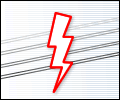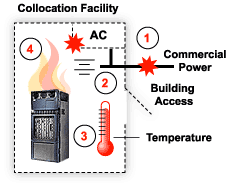|
In this issue ...
DPS Telecom Combines Three Legacy Systems Into One
 |
| Dominion: John C. Mullen and Daniel Jackson - Lead Telecommunications Techs. |
Nine months ago, Dominion had a problem with unsupported legacy equipment. The Virginia-based energy giant operates an extensive internal communications network, and it was monitored by several different systems, all of which were no longer supported by the original manufacturer.
Dominion recognized that their legacy support problem was a serious business issue. Their internal network, which transports voice communications and SCADA telemetry data, plays an important role in guaranteeing reliable electricity service for Dominion's customers.
Unsupported legacy equipment was installed in 150 sites in a seven-state coverage area. "We had several different types of legacy remotes: Badger, Larse, and NEC," said Dan Jackson, a Dominion lead telecommunications technician. "The [Badger] master could go at any time," said Jackson's colleague John Mullen, another Dominion lead telecommunications technician. "If the master crashes, you never know if it's coming back," Jackson added.
Today, Dominion has a solution. DPS Telecom designed a new monitoring system for Dominion that incorporated their legacy remotes. Dominion now has a full-featured modern system that can grow with their future needs, and they achieved this without having to do a forklift replacement of their legacy remotes.
"The thing I liked was that DPS was going to make it fit our needs. There weren't going to try to make our stuff fit their stuff. They were going to make their stuff fit ours. I like that. I like that a lot," said Jackson.
How Dominion avoided a forklift swap-out ...
Circumstances Outside Your Control Threaten to Wreck Your Business. Protect Yourself!
The blackout of August 14-15 cut off power to eight American states, one Canadian province, and at least 50 million people. Among the blackout victims were telecom providers in the affected area, who had to scramble to provide constant customer service during the outage. And while 99 percent of customers had service during the blackout, that still means that hundreds of thousands of customers had dead phones.
 |
| You never know when and where disaster will strike and how that will affect your customers. |
An event of this magnitude clearly demonstrates that network outages can happen for reasons totally outside the network. Many network outages are caused by factors that network operators cannot control. In recent years there have been a number of network failures linked to outside causes:
- Cable cut by outside personnel: Utility workers, public employees, and construction workers have halted telephone service for thousands of customers for hours by inadvertently cutting underground fiber while digging.
- Power Failure: Failure of commercial power creates many potential sources of network outage - and not just the obvious ones. Besides straining backup power sources, blackouts and power surges can blow fuses and trigger automatic shutdowns, cutting off service to customers.
- Weather: Storms regularly damage phone lines and commercial power transmission, resulting in dead phones for thousands of customers.
These factors don't just affect your quality of service report. They hit your bottom line - and the bottom line of your customers.
What are the business costs of network outages?
Do You Know What's Happening at Your Collocation Sites?
Why You Need to Monitor the Whole Facility - Not Just Your Equipment
 |
| Make sure backup power is supplied to both your DC power plant AND your A/C powered devices, such as air conditioners (AC). |
Knowing what's really going on at collocation facilities can be difficult to the point of impossibility. Whether you're a tenant at the facility, or even if you own the building, most of the site is outside your control.
But that's exactly why you need to monitor collocation facilities closely. If you're a collocation tenant, the factors you can't control - the general conditions of the facility and the actions of other tenants - can severely affect the revenue-generating equipment you've installed at the collocation site. Monitoring these factors will keep you a step ahead of potential threats to your network.
And if you're a collocation host, you have an even greater need to keep close tabs on your collocation facilities. Not only will conditions at the site affect your own equipment, you have a contractual obligation to provide your tenants with a specified standard of environmental conditions and site security.
3 Essential factors you should monitor at collocation facilities …
11 Ways You Can Avoid Windshield Time
 |
| Nobody likes windshield time ... not the technician heading out to a remote site, and not the carrier paying for his services. |
Proactive monitoring can avoid outages Pager notification keeps technicians where they belong - in the field Site visibility ensures that the right people, with the right tools, go to the site Reach-through ports to serial equipment Remote operation of equipment and relays Remote-site verification of master visibility simplifies turnup and troubleshooting Remote provisioning of masters and remotes Downloadable firmware Built-in debug features on remotes Remote tech support Dispatch route planning with T/GrafX
Learn more about reducing windshield time …
| Sign Up Now for DPS Telecom Factory Training
DPS Telecom will be hosting factory training classes at its headquarters in Fresno, California, October 27-30. The classes will cover all aspects of installing and operating the T/MonXM Network Alarm Management System, the NetGuardian, ASCII alarm processing, the new Remote Alarm Block 176, and more.
All classes will be taught by DPS Telecom technical support expert Johnny Maldonado. Johnny has performed over 100 onsite installations in the United States and abroad and has taught over 30 training classes. Johnny's hands-on approach to teaching has given his many students a more meaningful understanding of the setup and operation of DPS Telecom equipment.
Call 1-800-693-0351 today to reserve a place for this valuable instruction. Come and see why Johnny's students say "This class will make your job easier!"
|
|
|
